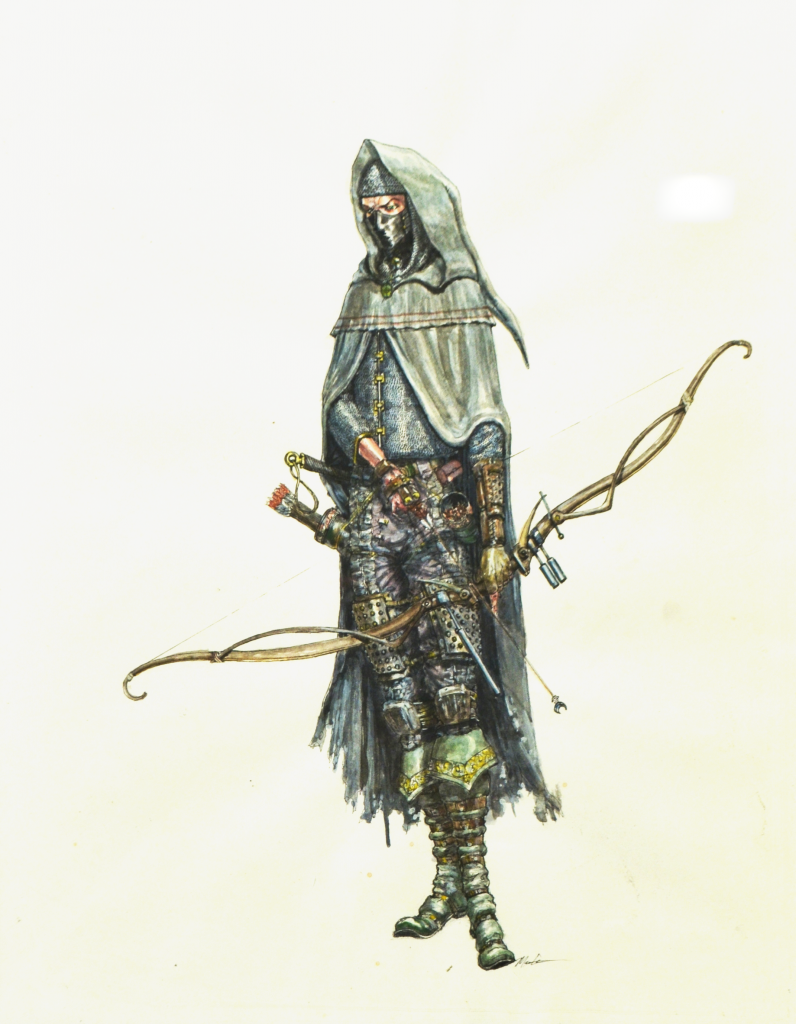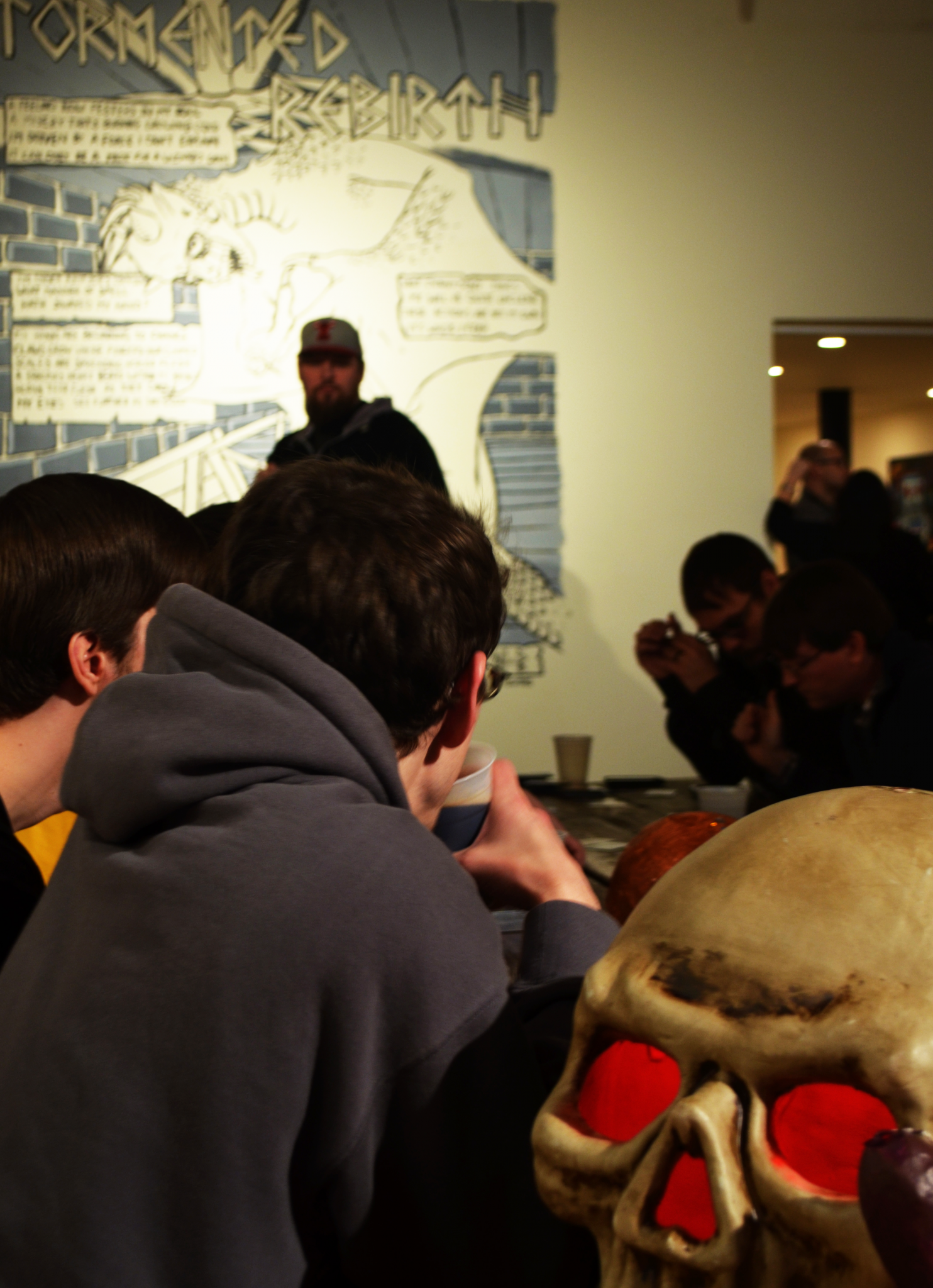Curator Ed Marszewski grabbed me by the shoulder. “You have no idea how seriously these kids—,” he checked himself mid-sentence, nodding at the grey heads in the crowd, “these old men take this!”
By “this,” Marszewski refers to Advanced Dungeons & Dragons, the theme of that evening’s happening (an art form in which the audience participates in a real-time performance). Hosted by the Co-Prosperity Sphere in Bridgeport, this fifth installment of the “Level Eater” series continued the tradition of using a regular gallery opening as an opportunity to run pen-and-paper role-playing sessions until four or five in the morning. Combining medieval-themed food-trucks and local craft breweries with visual art installations and live performances, “Level Eater” essentially magnified the basic idea behind a typical gaming session: get people who believe in your fiction into the same room, and work with them to radically reconstitute that space.
When first looking at the character portraits that Matt Hilker contributed to “Level Eater,” there’s an immediate impulse to shrink back from their excessive detail and decorativeness. The articulation of each chainmail link, an archer’s unique crescent-shaped arrowheads, the million little individualized pouches and caskets on a lady’s utility belt all err towards a kind of fantasy kitsch.
The conditions of the event’s staging help explain Hilker’s work. Friendly chatter about character skills builds over dark beer and the several Magic: The Gathering games being played all at once furnish some necessary and helpful context for the uninitiated. All of these people in your appreciative scrutinizing are themselves invested in bringing their imaginings into real terms. They do much the same work as every artist in his or her chosen medium. Hilker’s art openly cites a real practice of generating character sketches as a way to index and keep track of how a player’s persona develops over what could be a months-long, open-world game. The problem sometimes is not trusting in the fantasy, but remembering all the little things—the reality effects—that make it so lush and vibrant to players.
It’s important that Hilker’s portraits are not illusionistic. One easy response to grappling with the imaginary quality of a role-playing experience would be to adopt a hyper-real style. (This is a technique that videogames, for example, attempt as an industry standard.) Hilker’s deliberate stroke, his mark with his various tools, is present all throughout his designs; the figures are not rendered with photographic authenticity. They are, instead, remarkable accountings of histories and symbols crafted by a readably human presence.
Artists Stephanie Burke and Jeriah Hildwine were responsible for the site-specific, larger-than-life “Tormented Rebirth” murals on the Co-Prosperity Sphere’s far wall. Burke said they both had been introduced to the happening by former “Level Eater” curator Michael Garcia, while Hildwine added that “Level Eater” had, in turn, introduced him to pen-and-paper gaming, and exhaustively at that.

“We played what was basically my first game ever, that lasted—like—three days!”
Burke was generally satisfied with the art on the display, arguing that there’s a substantial cohort of artists who are informed by role-playing experiences, but treat them as trivial “bullshit.”
“It’s interesting seeing artists actually address that material,” she said.
The two panels of “Tormented Rebirth” are fantasy writ large. The protagonist of the monochromatic mural is undergoing a painfully slow mutation into a flame-gushing dragon, and finally bursts forth in the second panel to level a city from above. Hildwine credits the lyrics painted into the pieces (“What once was breath/Now sears like fire,” “Is this immutable change/Is it my new life?”) to a friend’s band out in Flagstaff, Arizona.
These words declare the work’s intention to interrogate the notion of self-transformation, which “Tormented Rebirth” does at more than just the literal level of the song. By scaling up to the dimensions of the room, “Tormented Rebirth” signals that the process of growing beyond your own skin—the kind of imaginative identity construction that role-playing sells—is something that nominally acts at an epic, totalizing scale. Hosting a game “explodes” the spatial and temporal conditions of your living room in much the same way the mural’s fictive monster flattens a town.
Hildwine argues that “Tormented Rebirth’s” monumentality has an additional, tone-setting dimension, citing a history of previously huge “Level Eater” installations. The size of “Tormented Rebirth” helps to foreground its proposal that role-play dominates an environment as a central issue for the “Level Eater” happening.
Hilker, Burke, and Hildwine—through particularity or grandiosity—all deal in the impulse that keeps artists and art beholders alike at a single game for seventy-two hours and propels “Level Eater” into its fifth time going. The Advanced Dungeons and Dragons rulebook that “Level Eater” celebrates is essentially a chance to run creativity through a complex network of conventions and get outside of yourself in the process. The “Level Eater” happening levels up the circumstances under which AD&D normally occurs, allowing us to think harder about the wyrm-winged life the series offers.

